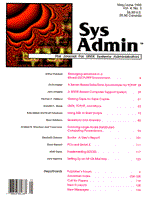
Sidebar: Setting Up an http Server
Although most web browsers are capable of viewing HTML-based pages by loading the files from disk, an httpd server will make it much easier to implement a set of pages. Several httpd packages can be found on the Internet; I have been most satisfied by the National Center for Supercomputing Applications' (NCSA) httpd. NCSA has precompiled binaries for many platforms, as well as source code available via ftp (see References for a list of sources). NCSA has moved its documentation to HTML format, so it can be accessed via the NCSA homepage or downloaded via ftp. Although the instructions for setting up the server are quite clear, you'll need to make several modifications to the configuration files if you plan to use httpd only with my scripts. First, unless you want to allow people outside your local network to access your homepages, you'll need to deny access to requests from hosts outside your domain. By default, all access control information is kept in the file conf/access.conf. In this file you will find a section similar to the following:
<Limit GET> order allow,deny allow from all </Limit>
To restrict access to local hosts, revise this section to look like this:
<Limit GET> order deny,allow allow from your.domain </Limit>
This will first deny access to all hosts, then allow access to any machine in the domain your.domain. where your.domain is your actual domain name. Next, add the line
IdentityCheck on
to the end of the httpd configuration file conf/httpd.conf. This will turn on RFC 842-based identity checking. This option is especially useful for scripts that need to know a user's identity. Unfortunately, to use this option, you must install something similar to identd on each machine. I have not yet been able to find a way to check the identity of a user sitting in front of a PC.
|